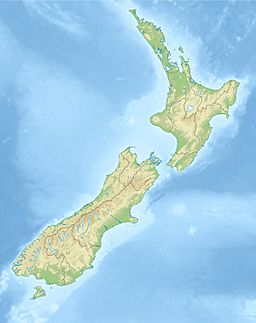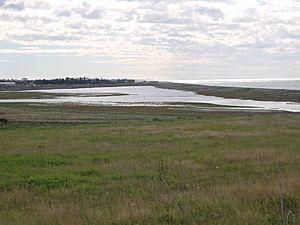Washdyke Lagoon facts for kids
Quick facts for kids Washdyke Lagoon |
|
|---|---|
| Location | Canterbury, New Zealand |
| Coordinates | 44°21′49″S 171°15′09″E / 44.3637°S 171.2525°E |
| Type | lagoon |
| Native name | Waitarakao Error {{native name checker}}: parameter value is malformed (help) |
| Surface area | 48 hectares (0.48 km2) |
Washdyke Lagoon is a shallow, salty lake near the coast. It is about 1 kilometre (0.62 mi) north of Timaru in South Canterbury, New Zealand. This special lagoon has shrunk a lot since 1881. Back then, it was about 253 hectares (630 acres) big. Now, it is less than 48 hectares (0.48 km2) in size.
A long beach, called a barrier, protects the lagoon from the sea. This barrier is 3 kilometres (1.9 mi) long and about 3 metres (9.8 ft) tall. The lagoon is shrinking because a port was built nearby. This port stops sand and gravel from reaching the barrier. Washdyke Lagoon and the land around it are a wildlife refuge. This shows how human buildings can change our coastlines.
Contents
What Kind of Lagoon Is Washdyke?
Washdyke Lagoon is a "choked" type of coastal lake. This means a natural sand and gravel bar separates it from the sea. Only a small amount of ocean water can get into the lagoon. These lagoons often form on coasts with strong waves and small tides. They usually have more fresh water than salt water. They also do not often open directly to the ocean.
Lagoons form when sand and other bits of rock, called sediment, build up. This happens because of something called longshore drift. This is when waves push sediment along the coast. The sediment builds a barrier that blocks a river or stream from reaching the ocean directly. For a barrier to form, it needs both fine and coarse sediments. Fine sediments often come from offshore. Coarse sediments usually come from river mouths. The barrier needs new sediment to keep growing. This helps it stay separate from the ocean. If the sea level rises, the barrier can be covered by water. If it falls, a smaller barrier can keep the lagoon separate.
Many closed lagoons like Washdyke exist around the world. They are very important for nature. Keeping the right mix of fresh and salt water is key for them. Examples include the Coorong in Australia and Lake St. Lucia in South Africa. If these lagoons lose their sediment supply, their barriers can wash away. Then, the lagoons would become open bays.
How Washdyke Lagoon Formed
Washdyke Lagoon formed because a special kind of beach barrier grew. This barrier is made of mixed sand and gravel (MSG). It allowed fresh water from Washdyke Creek to collect behind it. Some ocean water also seeps through the barrier. MSG barriers are quite rare. They form where there is a lot of coarse sand and gravel. This usually happens in places with strong storms. Storm waves can carry more sediment onto the shore. These barriers also have steep slopes. Fresh water can easily seep through them into the ocean. This is because the sand and gravel pieces are large.
Washdyke Lagoon is a good example of an MSG barrier. It shows all these features. The lagoon is located at the southern end of the Canterbury Bight. This coast has mixed sand and gravel beaches. Ocean currents here usually flow south. These currents carry coarse greywacke sediments. These sediments come from rivers that start in the Southern Alps. Fine sediments come from further offshore. The currents push these sediments north. They then build up on the Washdyke Barrier. This helps the barrier stay above the high tide mark and form the lagoon.
The southerly current in New Zealand creates many lagoons. These include Lake Ellesmere and Waituna Lagoon. Like Washdyke, these lagoons might become more open to the ocean soon. For example, Kaitorete Barrier, which protects Lake Ellesmere, is eroding. It might even break open permanently. Waituna Lagoon is also at risk. People sometimes open it to the ocean using machines. This is done for hunting or grazing. But opening it more often changes the lagoon's saltiness. We are still learning how this affects native fish and birds.
Why Washdyke Lagoon Is Shrinking
The lagoon is shrinking very quickly. The barrier has moved back 400 metres (1,300 ft) between 1865 and 1987. That is about 3.2 metres (10 ft) each year! In 1992, experts thought the lagoon might disappear by the year 2000. It has not happened yet, but it is still possible. If it disappears, the Washdyke industrial area could flood. Also, the wildlife refuge would lose its home.
A big reason for the lagoon shrinking is the Timaru Port. Building the port started in 1878. The port has a long wall, called a breakwater, that is 700 metres (2,300 ft) long. This breakwater blocks sediment from reaching Washdyke Lagoon. Since the port was built, the coast north of the port has lost a lot of sediment. But the coast south of the port has gained new land. This shows how much sediment is being blocked.
The port's breakwater stops coarse sediments from rivers to the south. Before the breakwater, both fine and coarse sediments reached Washdyke Barrier. But after the breakwater was built, coarse sediment gets stuck at the port. Some sediment does get around the breakwater, but it is much less.
Without new sediment, the barrier erodes quickly. Waves push sediment from the ocean side to the lagoon side. But there is no new sediment coming in to rebuild the ocean side. This means the barrier moves inland. The barrier also has more fine sediments. Coarse sediments protect the barrier from strong waves. Without them, the finer sediments are easily washed away. Waves here can be very high, sometimes 6.3 metres (21 ft). This means the barrier often gets covered by waves.
Another reason for less coarse sediment is the damming of the Waitaki River. This dam was built in 1934 for electricity. It is thought to stop half of the river's sediment from reaching the coast. The amount of sediment reaching the barrier is very important. It decides if the barrier stays strong or breaks down. This has been seen in other places, like Nova Scotia, Canada.
A similar problem happened at Waimataitai Lagoon. This lagoon was just north of Timaru Port. Its barrier eroded quickly after the port was built. By 1933, the lagoon was completely gone. It became an open bay. Around the world, human structures are causing beaches to erode. This can affect tourism and even destroy villages. For example, in Hallsands, England, a village was destroyed by 1917. This was because a seawall and gravel dredging stopped sediment from reaching the protective beaches. We now know that human buildings can stop natural sediment movement. Because of this, people are trying to avoid building such structures.
Pollution is also a problem for Washdyke Lagoon. In the past, a meat processing plant pumped waste water into the lagoon. Workers noticed the barrier getting thinner as early as 1897. More recently, there have been worries about pollution from the Washdyke industrial area. This area is right next to the lagoon. A sewage pipe also used to end on the ocean side of the barrier. It was used until 1998. This pipe was often exposed as the barrier eroded. It added pollutants and caused too many nutrients in the lagoon.
Helping Washdyke Lagoon in the Future
The entrance to Timaru Port is dredged every ten months. This keeps the channel deep for ships. About 100,000 cubic metres (3,500,000 cu ft) of fine sediment is removed each time. Since the early 1990s, some of this sediment has been dumped off the Washdyke coast. This is because 20% of it is coarse enough to help the barrier. However, most of the material is too fine. It is not as strong against waves as the original sediment.
From 1979 to 1985, the Timaru City Council tried to rebuild a part of the Washdyke Barrier. They wanted to protect a sewage pipe and see if it would work. A 300 metres (980 ft) section of the barrier was made 2–2.5 metres (6 ft 7 in – 8 ft 2 in) higher. They used sediment from the lagoon side and coarse sediment from the Opihi River. The project was successful. But no more rebuilding has been done since then. However, you can still see the effects of this work on the barrier today.
More work is needed to find the best way to protect the barrier. This work needs to be specific to Washdyke Lagoon. This is because it has unique challenges. Scientists are still studying mixed sand and gravel barriers. They do not fully understand how they behave over a long time. A challenge for the future is that Timaru Port is very important for the local economy. Some people might think that losing Washdyke Lagoon is a necessary trade-off.
Wildlife and Nature at Washdyke Lagoon
Washdyke Lagoon is a home and feeding ground for many birds. You can see waterfowl, godwits, sandpipers, herons, and other water birds. Gulls and dotterels build nests on the gravel barrier on the eastern side. But the number of black-fronted dotterels has been going down. You can also find saltmarsh ribbonwood, rushes, and other plants around the lagoon. A reef near the barrier attracts oystercatchers and turnstones. People also like to catch whitebait near the barrier.
The natural balance of lagoon systems is lost if their sediment supply is removed. If the barriers erode, the lagoons become open bays. This is what could happen at Washdyke Lagoon. It could also happen to other lagoons if human activities keep stopping natural sediment flow. This would harm the animals and plants. It would also cause flooding in areas like the Washdyke industrial area, which the lagoon currently protects.







